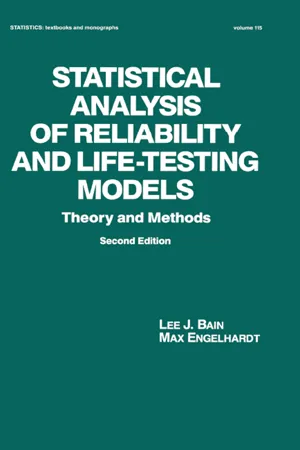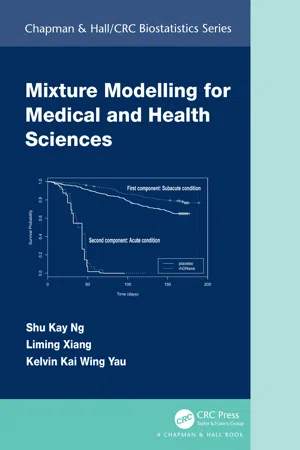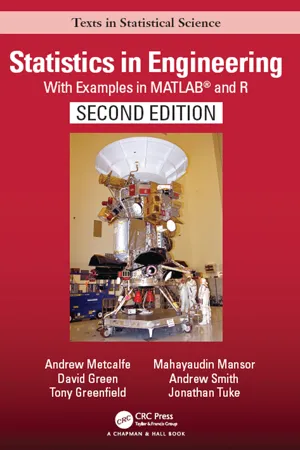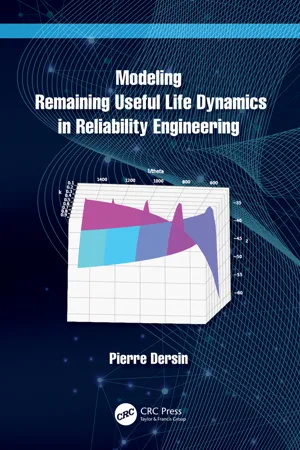Technology & Engineering
Gamma Distribution
The gamma distribution is a continuous probability distribution that is often used in engineering and technology to model the time until an event occurs. It is characterized by its shape and scale parameters, and is commonly used in reliability engineering to analyze the lifespan of components and systems. The gamma distribution is also used in queuing theory and risk analysis.
Written by Perlego with AI-assistance
Related key terms
Related key terms
1 of 4
Related key terms
1 of 3
5 Key excerpts on "Gamma Distribution"
- eBook - ePub
Statistical Analysis of Reliability and Life-Testing Models
Theory and Methods, Second Edition,
- Lee Bain(Author)
- 2017(Publication Date)
- Routledge(Publisher)
5 The Gamma DistributionThe Gamma Distribution is a classical distribution which has appeared in the literature since the early 1800s. Johnson and Kotz (1970) discuss this distribution and include 130 references. The three-parameter gamma density is given byf ( x; θ, κ, η)=1θ κΓ ( κ )( x − η )κ − 1e− ( x − η)/θx > η , θ , κ > 0 , − ∞ < η < ∞This distribution is also a Pearson type III distribution. Most emphasis here will be on the two-parameter Gamma Distribution with η assumed known, and thus taken to be zero, giving GAM(θ, κ, 0) = GAM(θ, κ).Letting θ = 2 and κ = ν/2 leads to the familiar chi-aquare distribution, GAM(2, ν/2). Also GAM(θ, 1) = EXP(θ). The chi-square distribution occurs frequently as a derived distribution of a statistic, but that is not the type of application of the Gamma Distribution to be considered here. In this chapter the Gamma Distribution is studied as a population model or “parent” distribution. The Weibull distribution was a generalization of the exponential distribution, and the Gamma Distribution provides an alternate generalization. The fact that these two distributions are of a some-what different nature is illustrated by comparing their HFs. Let δ = 1/θ. For κ = 1, the HF is constant h(x) = δ. For κ > 1, h(0) = 0 and h(x) approaches δ asymptotically from below as x → ∞. For κ < 1, h(0) = ∞ and h(x) approaches δ asymptotically from above as x → ∞. This is considerably different from the Weibull distribution where (β > 1) h(x) → ∞ as x → ∞. For example, this suggests the gamma may be useful as a population model when the items in the population are systems in a regular maintenance program. The failure rate may increase some initially, but after some time the system would reach a stable condition due to maintenance, and from then on would be as likely to fail in one time interval as in another. - eBook - ePub
- Kenneth S. Stephens(Author)
- 2011(Publication Date)
- ASQ Quality Press(Publisher)
t, then the failure distribution of the system is the Gamma Distribution, as follows:and this can be written in the following form with λ replacing 1/β, and with n as an integer parameter. This latter form is that of the Erlang distribution, which is a special case of the gamma with integer shape parameter n, and the gamma function term is replaced with its factorial counterpart. Here, the scale parameter is λ = 1/β, with β used in the previous form:These equations are shown in Chapter 3 as equations (44) and (43) , respectively. The exponential distribution itself is a special case of the Gamma Distribution with shape parameter n, in this case equal to 1. Make this substitution and note that the Gamma Distribution reduces to the exponential distribution. Later it will be shown that the chi-square distribution is also a special case of the Gamma Distribution.3.0 THE Gamma Distribution
Recall that the Gamma Distribution function was derived in section 11.0 of Chapter 2 starting with the mathematical function f(x) = xa e–x/b. The result as shown in equation (33) of Chapter 2 is the following:
Excel has both a probability function and an inverse function for the Gamma Distribution, as does Minitab.(16) As with the exponential distribution above, an Excel file has been prepared entitled CH 6 Gamma Templates with Graphs. The first tab, labeled “Gamma Probability Template,” involves three inputs of 10t replacing x in equation (14) , 10(n or α) (with only α used subsequently in the discussion, as α can take on an integer value often denoted as n), and 10β, all with spin buttons with a range of 0 (1) 300 for 10t with an effective range of 0.1 (0.1) 300, 1(1) 500 for α with an effective range of 0.1 (0.1) 50, and 1(1) 200 for 10β, which yields an effective range of 0.1 (0.1) 20. There are three outputs, the ordinate of the pdf, f(t; α, β), the cumulative probability of t or less, F(t; α, β), and the cumulative of t or more or the reliability R(t) = 1 – F(t). These are computed via Excel's GAMMADIST function with the following syntax: GAMMADIST(t, alpha, beta, cumulative) with the random variable t, here replacing x, the two parameters α and β, and a logical argument that returns f(t; α, β - Shu Kay Ng, Liming Xiang, Kelvin Kai Wing Yau(Authors)
- 2019(Publication Date)
- Chapman and Hall/CRC(Publisher)
3 Mixture of Gamma Distributions for Continuous Non-Normal Data3.1IntroductionMany random variables of interest in medical and health sciences are non-symmetrical (or skewed), such as healthcare cost and utilization data. In this chapter, we introduce mixture models with gamma component distributions for handling clusters in the data that show non-symmetrical characteristics. Several other non-symmetrical component distributions can also be considered, such as skewed normal or skewed t -distributions. As described in Chapter 2 , non-normal features in the data may be attributed to some underlying group structure, thus it is essential to compare to mixture models with symmetric component distributions (such as normal or t -distributions) as well.The Gamma Distribution family is flexible to model data exhibiting different degrees of skewness. A typical gamma density function involves two parameters: μ quantifies the mean and α represents the shape of the Gamma Distribution. In other terminology, σ 2 = μ 2 /α represents the variance of the data, while θ = μ /α = σ 2 /μ is known as the scale parameter. The Gamma Distribution is a continuous distribution defined on positive values of the random variable. Figure 3.1 displays Gamma Distributions with various shape (α ) and scale (θ ) parameters. It can be seen from Figure 3.1 that the gamma density function is unimodal and skewed when the shape parameter α is greater than 1. When α increases, the skewness decreases. For α < 1, the gamma density function is exponentially shaped. The Gamma Distribution is useful for modelling positive and positively skewed random variables, including healthcare costs (Jones et al., 2016; Venturini, Dominici, and Parmigiani, 2008), hospital length of stay (Lee et al., 2002; Lee et al., 2007), insurance claims (Jeon and Kim, 2013), intensity of ultrasonic images (Destrempes et al., 2009), evolutionary rates across nucleotide and amino acid sites (Mayrose, Friedman, and Pupko, 2005), human reference intervals in clinical pathology (Concordet et al., 2009), and waiting times (Mohammadi, Salehi-Rad, and Wit, 2013); even though the data are sometimes recorded as an integer and can thus be considered a count variable. In this case, Poisson distribution may also be considered, but the Gamma Distribution offers more flexibility in modelling data in terms of the variance-to-mean ratio (or known as the index of dispersion) of data represented by θ- eBook - ePub
Statistics in Engineering
With Examples in MATLAB® and R, Second Edition
- Andrew Metcalfe, David Green, Tony Greenfield, Mayhayaudin Mansor, Andrew Smith, Jonathan Tuke(Authors)
- 2019(Publication Date)
- Chapman and Hall/CRC(Publisher)
This may be used to calculate any probability required. As for any mathematical model, a probability distribution is an approximation to reality. It follows that there is no correct distribution. However, some models are better than the others. Probability plots can be used to assess the goodness of fit, and to choose between probability distributions, for particular applications. Also, there may be conceptual reasons for choosing a particular model, such as a Gumbel distribution for extreme values. TABLE 5.3: Continuous probability distributions. Distribution Support PDF, f (x) Expected value, µ Variance, σ 2 Uniform [ a, b ] 1 b − a a + b 2 (b − a) 2 12 Exponential [0, ∞) λ e − λ t 1 λ 1 λ 2 Normal (−∞, ∞) 1 2 π σ e − 1 2 (x − μ σ) 2 µ σ 2 Lognormal (0,. ∞) 1 x 2 π b e − 1 2 (ln (x) − a b) 2 e a + b 2 2 e 2 a + b 2 (e b 2 − 1) Gamma [0, ∞) λ k t k − 1 e − λ t Γ (k) k λ k λ 2 Gumbel (−∞, ∞) 1 θ e − x − ξ θ e − e − x − ξ θ ξ −. Γ′(1) θ π 2 6 θ 2 5.9.3 MATLAB and R commands In the following, data is a vector containing data points, x is a value (scalar or vector)in the support of the corresponding distribution. The variables mu and sigma are the expected value (µ) and standard deviation, respectively, for the corresponding distribution and n is some integer. The variables a and b are the parameters for the corresponding distribution and lambda is the rate for the exponential distribution - Pierre Dersin(Author)
- 2023(Publication Date)
- CRC Press(Publisher)
But the knowledge that the LED has operated correctly during 1500h is much less informative than in the previous case (where it had been seen to operate correctly for 3000h) and therefore, it teaches us much less in addition to what we knew already, i.e., the a priori probability distribution of the time to failure.5.5 Application to Gamma Distribution
The reliability function for the Gamma Distribution is given (Birolini 2017 ) as follows, in terms of a scale parameter λ and a shape parameter β:The scale parameter has the dimension of the reciprocal of a time, and the shape parameter is dimensionless.R(5.42)( t )= 1 −1Γ( β )∫ 0λ txβ − 1ed x .− xExpectation E(T) and varianceσ 2can be expressed in terms of those two parameters:E(5.43)( T )=β λ(5.44)σ 2=β.λ 2Application of Theorem 5.1 leads to the following expression for the g(.) function:g(5.45)( t )=μ k[.1 −](1 −)1Γ( β )∫ 0λ txβ − 1ed x− xk1 − kThis expression contains the two parameters µ and k of the corresponding distribution with MRL linear in time into which the Gamma Distribution is transformed by g(.). They can be derived in terms of the two parameters of the Gamma Distribution, by means of (5.4) and (5.8).There follows:µ =(5.46)β λk =(5.47).β − 1β + 1It is verified that, as expected, the limiting case k = 0 corresponds to the exponential distribution (β = 1), and the limiting case k = 1 corresponds to the Dirac distribution and to β→ ∞.This is consistent with the fact that, for the Gamma Distribution, the coefficient of variation CV vanishes asymptotically as β→ ∞, sinceC V ≡(5.48)σ=E( T )1 β.Those results are summarized in Table 5.1 .The g(.) function is plotted against time in Figure 5.5 .The expression in (5.45) contains the lower (regularized) incomplete gamma function. A short Python program to compute g(t) is provided in Table 5.2 . It takes β, λ, and t as inputs, and returns g(t) as its output.Table 5.1
Index pages curate the most relevant extracts from our library of academic textbooks. They’ve been created using an in-house natural language model (NLM), each adding context and meaning to key research topics.
Explore more topic indexes
Explore more topic indexes
1 of 6
Explore more topic indexes
1 of 4




